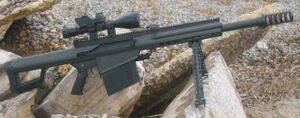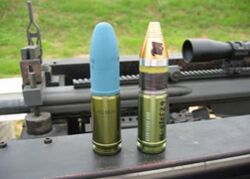Engineering:Barrett XM109
| Barrett XM109 AMPR | |
|---|---|
 | |
| Type | Anti-materiel rifle Grenade launcher |
| Place of origin | United States |
| Production history | |
| Designer | Ronnie Barrett |
| Manufacturer | Barrett Firearms Manufacturing |
| Specifications | |
| Mass | 33.2 lb (15.1 kg)[1] |
| Length | 46 in (120 cm)[1] |
| Barrel length | 17.6 in (45 cm)[1] |
| Cartridge | 25 × 59 mm[1] |
| Calibre | 25mm |
| Action | Semi-Automatic, short recoil[1] |
| Feed system | 5-round detachable box magazine[1] |
The Barrett XM109 is a prototype anti-materiel rifle, chambered for 25 × 59 mm grenade rounds and developed by Barrett Firearms Manufacturing. It was designed in accordance with a requirement set out in 1994, and is capable of defeating light armor and equipment out to 2 km (1.2 mi).[1]
Prototypes of the XM109 have existed since the late 1990s and studies of the weapon's effectiveness were released in 2002; 10 prototypes were known to exist in 2004, and the XM109 and Barrett XM500 were folded into a broader Anti-Material Rifle Congressional Program in 2006.[2] The current status of the XM109 is not particularly clear, with no news of either cancellation or potential adoption.
Overview
The XM109, originally known as the Objective Sniper Weapon (OSW) and now called the Anti-Materiel Payload Rifle (AMPR), is a semi-automatic anti-materiel rifle, designed primarily for engagement of light armored vehicles and similar targets. The design uses the lower receiver from an M82/M107, but with a new upper receiver chambered in 25mm. The upper receiver of the M82 rifles can be replaced with an XM109 upper receiver to form a fully functional XM109 rifle.[1]
The 25 × 59 mm round that is used in the XM109 is the same one originally developed for the cancelled XM307, product of the Objective (later Advanced) Crew Served Weapon program (OCSW / ACSW). As with the XM307, the XM109 can be reconfigured back to .50 BMG, in the XM109's case this is done by swapping the 25mm upper receiver for a standard M82 / M107 upper.
The XM109 offers greater range and a shorter overall length than the previous M82/M107 systems, as well as potentially greater power in the 25 × 59 mm cartridge over even the Mk 211 .50 BMG cartridge (AKA "Raufoss round"). However, the small amount of propellant and heavy projectile resulted in unacceptably high recoil due to limiting the effects of the weapon's muzzle brake, with a recoil force of over 60 foot-pounds compared to 36 for the M107. As of 2004, one of the project goals was to reduce the weapon's recoil.[2]
Other features
- M1913 optical rail
- BORS ballistic computer
- monopod socket
- Dual-chamber detachable muzzle brake or suppressor system
- detachable bipod and carry handle
See also
- Norinco LG5 / QLU-11
- Barrett M82
- List of firearms
- List of individual weapons of the U.S. Armed Forces
- Barrett XM500
References
- ↑ 1.0 1.1 1.2 1.3 1.4 1.5 1.6 1.7 Gates, Bob. "XM109 Briefing Update May 11, 2004". Barrett Firearms Manufacturing, INC. http://www.dtic.mil/ndia/2004arms/session6/gates.ppt. Retrieved 16 December 2012.
- ↑ 2.0 2.1 "XM109 Anti-Materiel Payload Rifle (AMPR)". Globalsecurity.org. http://www.globalsecurity.org/military/systems/ground/m109-ampr.htm. Retrieved 16 December 2015.
External links
- Official Website of Barrett Firearms Company
- An image of the XM109, Popular Mechanics
- GlobalSecurity.org - M109 Anti-Materiel Payload Rifle (AMPR)
- DTIC Briefing on XM109


